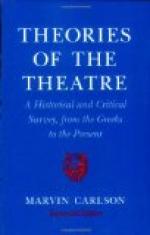With the rapid development of the theatre after the Restoration, came a movement toward greater naturalness in the conventions of acting. The player in the “apron” of a Queen Anne stage resembled a drawing-room entertainer rather than a platform orator. Fine gentlemen and ladies in the boxes that lined the “apron” applauded the witticisms of Sir Courtly Nice or Sir Fopling Flutter, as if they themselves were partakers in the conversation. Actors like Colley Cibber acquired a great reputation for their natural representment of the manners of polite society.
The Drama of Conversation, therefore, was acted with more natural conventions than the Drama of Rhetoric that had preceded it. And yet we find that Charles Lamb, in criticising the old actors of the eighteenth century, praises them for the essential unreality of their presentations. They carried the spectator far away from the actual world to a region where society was more splendid and careless and brilliant and lax. They did not aim to produce an illusion of naturalness as our actors do to-day. If we compare the old-style acting of The School for Scandal, that is described in the essays of Lamb, with the modern performance of Sweet Kitty Bellairs, which dealt with the same period, we shall see at once how modern acting has grown less presentative and more representative than it was in the days of Bensley and Bannister.
The Drama of Rhetoric and the Drama of Conversation both struggled on in sporadic survivals throughout the first half of the nineteenth century; and during this period the methods of the platform actor and the parlor actor were consistently maintained. The actor of the “old school,” as we are now fond of calling him, was compelled by the physical conditions of the theatre to keep within the focus of the footlights, and therefore in close proximity to the spectators. He could take the audience into his confidence more readily than can the player of the present. Sometimes even now an actor steps out of the picture in order to talk intimately with the audience; but usually at the present day it is customary for actors to seem totally oblivious of the spectators and remain always within the picture on the stage. The actor of the “old school” was fond of the long speeches of the Drama of Rhetoric and the brilliant lines of the Drama of Conversation. It may be remembered that the old actor in Trelawny of the Wells condemned a new-style play because it didn’t contain “what you could really call a speech.” He wanted what the French term a tirade to exercise his lungs and split the ears of the groundlings.




